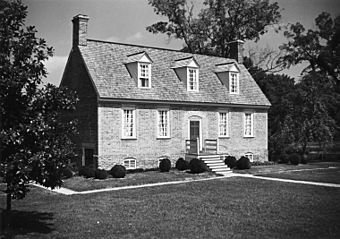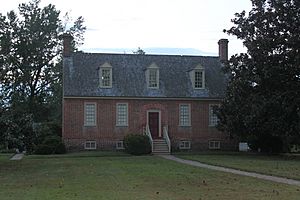Smith's Fort Plantation facts for kids
|
Warren House
|
|

Front Elevation of 1751 Main House (photo by United States Department of the Interior)
|
|
| Location | Surry County, Virginia, United States of America |
|---|---|
| Built | 1751 |
| NRHP reference No. | 73002065 |
Quick facts for kids Significant dates |
|
| Added to NRHP | November 14, 1973 |
|
Smith's Fort
|
|
| Lua error in Module:Location_map at line 420: attempt to index field 'wikibase' (a nil value). | |
| Nearest city | Surry, Virginia |
|---|---|
| Area | 5 acres (2.0 ha) |
| Built | 1609 |
| NRHP reference No. | 70000827 |
| Significant dates | |
| Added to NRHP | June 15, 1970 |
Smith's Fort Plantation is a historic place in Surry County, Virginia, USA. It includes a main house and a piece of land. The house you see there today was built in 1751. It is also known by other names like Warren House or Faulcon House. Some people even thought it was built much earlier, in the mid-1600s. This house has been a model for many new buildings created in the 1900s.
Contents
History of the Plantation
Early Beginnings: Captain Smith's Fort
The plantation got its name from a fort built by Captain John Smith in 1609. This fort was called "New Fort." It was located right across the James River from the Jamestown colony.
Sadly, the fort didn't last long. It was quickly left behind because of problems like wood rot and too many rats.
Land Gift to Pocahontas and John Rolfe
Later, this same land was given as a gift. Chief Powhatan gave it to John Rolfe when he married Powhatan's daughter, Pocahontas. This was a special dowry, a gift given at a wedding.
The Current House: Built in 1751
Experts have studied the land and found signs of many old buildings. The main house you see today was built by Jacob Faulcon in 1751. Before Faulcon, the land was owned by Thomas Rolfe and a man named Thomas Warren around the 1650s.
Preserving History
Who Owns and Cares for It?
The property and the house were bought by Preservation Virginia in 1933. This group used to be called the Association for the Preservation of Virginia Antiquities. They work to save historic places.
Restoration and Museum
The house was carefully restored with money from John D. Rockefeller Jr.. Today, Smith's Fort Plantation is open as a museum. Visitors can see furniture and items from the late 1500s to the early 1700s.
The property also hosts a fun event each year. It's called the Old Virginia Christmas-Festival of Crafts.
Archaeological Discoveries
What Captain Smith Said
Captain Smith wrote about his fort. He said it was "near a convenient River upon a high commanding hill." He also noted it was "very hard to be assaulted and easy to be defended." This description matches the location of Smith's Fort Plantation.
Searching for the Fort
Archaeologists have done some digging at the site. They found parts of a ditch and a worn-down rampart (a defensive wall of earth). More archaeological work is needed to be absolutely sure this was the exact spot of Smith's fort.
However, experts like Hume believe it is the right place. The way the earthworks were built is very similar to other old forts, like those found on Ronoake Island. This suggests it was indeed Smith's "retreat" or safe spot for trading groups.


